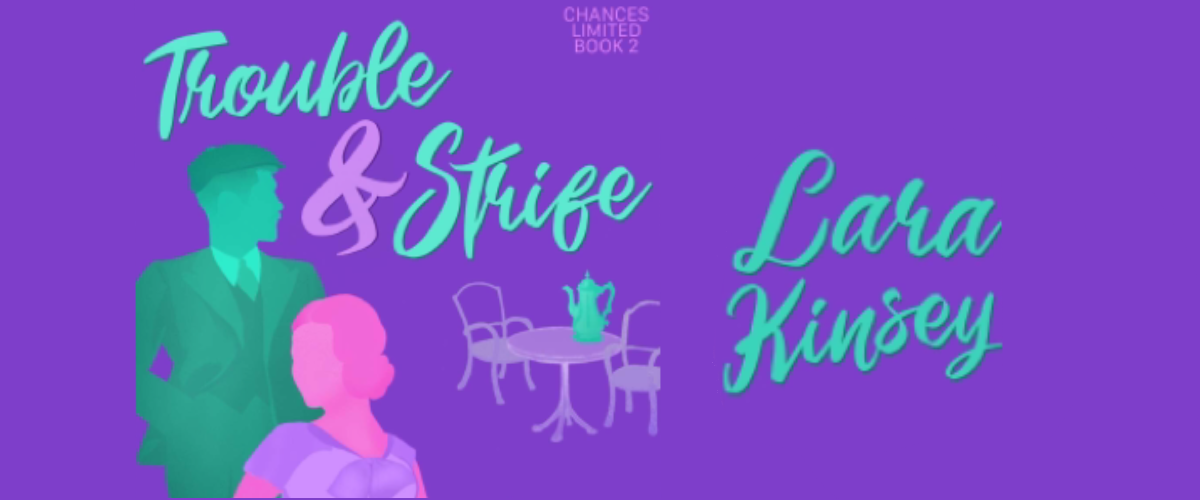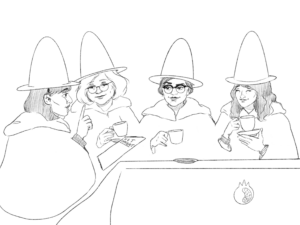For a lot of us—though, definitely for me, specifically—quarantine has been the perfect time for ~romance~ (albeit fictional). There’s a lot to be said for embracing the sensuality of romance as a genre, and really, who better to say it than an expert: a romance author, herself. So, we were thrilled for this opportunity to chat with Lara Kinsey to talk about her latest book, Trouble & Strife, and about her creative journey into the romance genre more broadly.
Jenny Mott (POME): You’ve produced an impressive amount of work, and all with published dates in just the past few months—how long have you been writing, and what got you into it?
I started reading romance in a big way in 2016, but I didn’t start writing romance until September 2019. My first short, Worth the Wait, was published in March 2020. That was a quarantine project. I’ve since published two novellas, four shorts/novelettes, a translation, and an audiobook.
I’m a big romance reader, and I used to do a lot of nonfiction writing professionally. I’ve never written much fiction before! I’ve written a few romance reviews for independent publications as well (though I’ll never reveal my secret identity), and I used to have a humor newsletter.
POME: That’s incredible! To have started so recently and have produced so much! Can you tell us what sparked the shift from avid romance reader to writer?
Everything goes quickly because I do most of it myself. I have a fantastic editor, Erica Russikoff over at ericaedits.com, but I make my own covers and do my own formatting.
But, as for how I got started: some writers I adore (Rebekah Weatherspoon, Katrina Jackson, Talia Hibbert, Alisha Rai) either got their start in self-publishing or do a mix of self-publishing and traditional publishing. They really provided the road map for me. I wrote my first book because I couldn’t get the characters out of my head, and I wrote the second book for the same reason, and hopefully I’m learning a bit along the way.
POME: Do you have any advice or resources for other people who are looking to get into this kind of writing and publishing themselves?
I love KJ Charles’s blog, Jami Gold’s blog, The Business of Being a Writer by Jane Friedman, and Romancing the Beat by Gwen Hayes.
POME: OK so, here at pome, we are well-known lovers of all things romance, but what was it that really drew you to the genre?
Romance for me is all about agency over body and soul, and I love to give my characters agency in their stories. I love a happily ever after, and it’s especially important to me to see marginalized people get a happy ending (thinking of this powerful article from Jaime Green).
Representation is great anywhere, but I was sick of the “bury your gays” trope. I wanted to write queer happy endings, and to carve out those happy endings for my characters. I think a lot about Dan Levy’s decision to write Schitt’s Creek without any homophobia was very powerful. When asked about that choice, he said:
“I have no patience for homophobia. As a result, it’s been amazing to take that into the show. We show love and tolerance. If you put something like that out of the equation, you’re saying that doesn’t exist and shouldn’t exist.”
It resonated with me, because historical authors, in particular, get pushback when the happily ever after for our characters is “unrealistic,” and we often have to produce receipts and research. Not that anyone questions 10,000 dukes with perfect teeth running around Regency London! That criticism is amplified for authors of color, and Beverly Jenkins and Adriana Herrera have been fantastic at pushing back against that type of thinking.
The first time I saw a heroine with chronic illness (Reggie in Can’t Escape Love by Alyssa Cole), it was very meaningful for me. So, I hope I give other people the chance to see themselves in my books.
POME: Oh that’s a great point about historical romance, in particular. And this might just be my personal axe to grind, but: horrible!! Even outside of the Romance genre, we somehow have hundreds of speculative historical fiction novels about what if the Nazis won WWII, but no: What if queer people and people of color were allowed to just exist peacefully in some cute old-timey aesthetics?? I know that, as a reader of historical fiction, I really do love the old-timey aesthetics—but there is more to it than that! What drew you to this particular subgenre?
Well, for one thing: I’m a history nerd, and I love language and folklore. So, the way I write tends to be well-suited to historicals.
But mostly, showing these queer happily ever afters is so important to me, in large part because modern readers often assume that the past was universally more prudish and restrictive on all counts. But, a lot of the policing of queerness began with the Victorians. Individual attitudes towards homosexuality (which is a fairly modern term, historically speaking) had previously been far more permissive on an individual basis than most people realize. To me, it’s not a matter of rewriting history. People have been here and queer for a long time. It’s a matter of embracing all the ways people found to have happily ever after.
For example, for Budding Romance, there was this concept at the time of “Boston Marriage,” when two women in academia would live together and set up a household. Nicolette is not an academic, so a solution that simple wouldn’t present itself, but the acceptance of her community grants the same leeway.
POME: Can you expand on that thought—on this idea of seeing marginalized people get a happy ending, even in historical settings, when the means of pursuing happiness might have been more restricted than they are now?
It just becomes a different conversation when you’re not writing rich dukes in M/F pairings. I adore heroes and heroines who live their values and who seek balanced partnerships. I’m particularly thinking of Remembrance in The Craft of Love by EE Ottoman, who doesn’t use sugar or indigo because she’s an abolitionist, and she’s trying to form a union. Her love interest, a shy trans man named Benjamin, is an expert silversmith, and the two of them are both independent craftspeople. That relationship is very much one of equals. Or Agatha in The Care and Feeding of Waspish Widows by Olivia Waite, who is very aware of the legal limitations of her happy first marriage, even as she prints subversive pamphlets about Britain’s landmark royal divorce case and romances a lady beekeeper. Or all the joyfully sex-positive heroes and heroines now populating historical romance.
I wrote heroes who were strong enough and powerful enough to discard society’s norms around gender and sexuality, but it’s critical that it’s their power that gives them that ability. Or, as in the case of Elizabeth in my latest work, Trouble & Strife, I wrote a heroine struggling with pelvic pain and chasing her pleasure, which is still very relevant today.
Chronic pelvic pain is incredibly common in people with vaginas, and roughly 1 in 4 will have some sort of painful intercourse over the course of their lifetime. I struggled with chronic pelvic pain in my early 20s, and it can be really isolating. I was already a big romance fan, and I looked for books that mirrored my experience. I found several good ones (Silver Moon by Catherine Lundoff has post-menopausal lesbian werewolves, Get a Life! Chloe Brown by Talia Hibbert has a heroine with chronic pain from fibromyalgia), but nothing that exactly fit my situation.
With any chronic condition, there are good days and bad days. After I finished physical therapy, I wanted to show that you could have these issues, but by knowing your body and guarding your limits fiercely, you can have really wonderful sex with the right partner. It means so much to me that I wrote a book that can actually help people. And it’s hot! That’s the best part.
If they can carve out these happy endings with the tools they had available to them, surely there’s hope for the rest of us.
POME: I mean, we do love a happy ending. And, your branding is very much “high-heat happily ever after,” specifically. Just how much heat are we talking? ????
For how short most of them are, I pack a lot of sex in there. Slow-burns, these aren’t. My characters fall for each other pretty quickly, because that’s what I’m like. I fall hard. My books tend to be on-page explicit, at the very least, and my Chances Limited series veers into kinky territory with some gentle femdom. The carrot on the cover of Hammer & Tongs is a little hint—in romance fandom, the carrot emoji means pegging.
POME: Ah! Amazing! I love to learn!
I’m not sure if you’ve seen the Cordelia poster, but it’s definitely giving romance Twitter ideas.
POME: OK but your latest book—Trouble & Strife—that’s Book 2 in the Chances Limited series. So, what do we need to know going in?
Trouble & Strife can be read as a standalone, which means you don’t have to read Hammer & Tongs, you’ll get a better sense of the world if you do. The series takes place in 1920s Birmingham—if you’ve ever seen Peaky Blinders, you may be familiar with the setting. But, the Peaky Blinders were just one of many razor gangs that struggled for territory over several decades.
The Chance Brothers, Sidney and Isaiah, run several local businesses, and they’re sort of the big bosses in their neighborhood—not quite criminals, but certainly not law-abiding citizens.
Isaiah, who is the hero of Hammer & Tongs, feels very much that he has to be perfect, that everyone is relying on him—he’s the reason wages get paid on time, he runs fair factories, and he has very strong opinions about equality that make his gang a safe place for people who wouldn’t be safe elsewhere. When he meets Brighid, her competence absolutely knocks him over, and it lets him unwind a little. Letting Brighid take control is the beginning of something for him. He can let go of the perfectionism that’s hurting him and he can learn to lean on people.
Sidney, the older brother and the hero of Trouble & Strife, has his own demons to deal with. Sidney’s never quite forgiven himself for not being able to step up and lead. He’s the older brother, but Isaiah’s very much the head of the family. He’s never felt completely comfortable in social situations. Brawling for him was a way he could be physical, even aggressive, and have it not be the wrong thing. As the Chance Brothers go legit, Sid needs to figure out what he can contribute beyond smacking heads together.
Sidney is such a lovely book boyfriend, because he’s quite soft. He knows he’s very intimidating, physically, and he holds himself tightly in check. Elizabeth, the heroine of Trouble & Strife, is a strong woman, and she’s wooing Sidney, who’s happy to be led. A reviewer called Sidney a “service top” and I think that’s exactly right.
POME: When I mentioned this book to the other POMEs, we could not get over what an absolutely big brain idea this was—the former enforcer with the ambitious chocolatier. And I can attest that your headmistress/master gardener pairing in Budding Romance was equally ingenious. What do you look for when you’re coming up with these juxtapositions and how are you so good at it?
*Blushes.* I like the idea of romance as finding your perfect person (or people). There is definitely a fantasy element in romance, but I want to leave my characters in relationships that would work in the real world. My books have been called low-angst, and very little of the drama in the stories comes from within the relationship. Romance stories usually have a bleak moment or fight in the third act. Mine is usually just a matter of whether the couple can argue fairly when their buttons are pushed and then reconcile after the hurt feelings. It’s a great test for real-world relationships too.
With Sid and Elizabeth, the couple in Trouble & Strife, Sid hates to be in control, and here’s Elizabeth, ready to take charge. She is compulsively complimentary, and he adores it. It’s about finding their match. I want my main characters to learn from each other, but I don’t want them to be the magic wand that fixes the other person. So I like to give them complementary baggage. Elizabeth and Sidney both had bad dads, but where hers was controlling, his was neglectful. And Elizabeth is learning to let go of her very curated self-image, while Sid is learning to take care of himself and really parent himself in a way he didn’t have growing up.
POME: Where can we find Trouble & Strife?
Trouble & Strife is available in Kindle and Paperback from Amazon.
POME: Where can we find you and your other works?
All my works are on Amazon. My latest, Blooming in the Sun, is available free to my newsletter subscribers here. My website is LaraKinsey.com. I’m on Twitter @LaraKinseyBooks.
Universal Buy Links:
Forjado a fuego (Spanish edition of Hammer & Tongs)
You can also request the audiobook of Hammer & Tongs from your local library, and the Trouble & Strife audiobook will be out on October 20th. I want to add that Hammer & Tongs is available in Spanish as Forjado a fuego, and the Italian edition, Forgiati nel fuoco, will be coming out in October.
POME: Any closing thoughts? Tidbits or advice you’d like to share?
This reader review has stuck with me: “Kinsey crafts a world in which there is pleasure to be found all over—in who you are, in the work you do, in what you can give to others, in companionship and sex and love.” I hope I empower my readers to seek that pleasure.
And if you want to read through some of the questions that didn’t make it into this piece, head on over to our Patreon!




